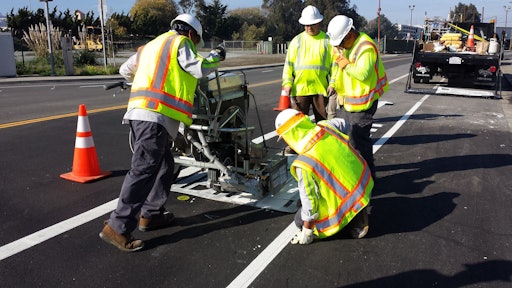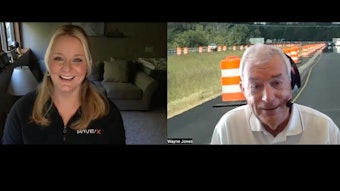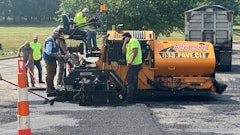
Here’s a story that just about every contractor can relate to. It involves a vision, a plan, unexpected growth and the struggle to get to “the next level” in a business. It involves very long days, learning skills you might not have wanted and doing work you’d never planned to do. And it involves success.
But because of its organization its success is constrained. So Tri-Valley Striping is in the midst of a process to transition an owner-led, owner-operated pavement marking business into a contracting business that relies on systems and practices to continue to grow and be successful.
“We’ve maxed out what I could handle by myself,” Owner Landy Rath says. “We want to develop a system so everything can run more smoothly and more efficiently.”
Rath never planned on being in the pavement marking business. In fact for 10 years she worked as an accountant, then followed that by getting a computer science degree and worked 10 years as a computer programmer. In 2004 her brother-in-law (who was manufacturing wheel stops) asked her if she wanted to learn about striping and start a striping business together.
“It came completely out of the blue,” she says. “I had no plans to do it but I figured, why not?” So she worked for a year on another contractor’s crew, learning the field work, then she and her brother-in-law started their own business.
In 2008 they decided to go their separate ways and Rath started Tri-Valley Striping, based in Orinda, CA. The company works primarily in the Greater Bay area of Northern California and generates 60% of its sales working for paving contractors. Another 30% is work for general contractors and the remaining 10% is property owners and managers. Tri-Valley Striping is small, with 10 people in the field and three people in the office (husband Dan works weekends and “as needed”).
Through August Tri-Valley Striping had 370 jobs completed or on its schedule (job values ranged from $275 to $50,000), and Landy Rath was involved in all of them because she is the face of Tri-Valley Striping. She’s always been the face of the company, she enjoys being the face of the company, the customers like working with her – and she’s good at it.
The problem is that all aspects of the business -- everything -- go through her. She does what many owners of small and growing businesses do: She meets with customers, walks the jobs, designs the plans, bids work, orders supplies, manages the staff, schedules the jobs, dispatches the crews and invoices the customer.
And while that worked for years, Tri-Valley Striping has reached a point where Landy Rath can’t be the focal point any longer. If the customers are going to be serviced properly and the company is going to continue to grow, systems need to be put in place so that other people can take on some of Landy Rath’s responsibilities.
Sound familiar? It should because many, many contractors start a business because they have a technical skill to get a job done. As the company grows that owner/operator becomes a jack-of-all-trades, handling aspects of business she (or he) never planned on.
“People get into business and everything takes over,” Landy says. “There are so many things we have to do and I do them even though I’m not the best person to do them. But because everything is so intertwined I do them.”
And that’s what Tri-Valley Striping is working to change.
“We want to take the day-to-day operational work off her plate and leave her with customer interface and developing new business,” Dan says. “We want her to be the face of the company. We want to keep the woman focus because that presents a different face and different kind of company to everyone we work with.”
In fact, Landy has been unable to take advantage of the company’s status as a Women’s Business Enterprise (WBE) and Disadvantaged Business Enterprise (DBE) – which can fill those needs as a subcontractor for paving companies and GCs – because she is so involved in all aspects of the company. “We know we can really take advantage of WBE and DBE but we haven’t been able to take the time to focus on that,” Landy says. “As my time gets freed up we’ll really pursue taking advantage of that.”
Dan and Landy say they knew the company would eventually get to the point where Landy couldn’t be involved in every aspect. So about two years ago they started to shift responsibilities to other people.
“We were doing okay for a while but then the business unexpectedly took another jump and it was all we could do to focus on that and service all the customers,” she says. “We really want to continue to grow but we’re beyond where we can go with just me.”
Identifying Areas for Systems
Dan says there are four broad areas the contractor is working to improve “and eventually we will link them all together.” The areas are client relations (including Customer Relationship Management), bidding (including job costing), dispatch (including improved job descriptions), and invoicing.
“Basically we’re trying to set up a whole new process that frees Landy up and that is more of a centralized system to move jobs from initial customer contact, to bidding, through scheduling and dispatch, and into the invoicing process,” he says.
Tri-Valley Striping has hired three office employees who are learning that side of the business and slowly taking some responsibilities off Landy’s plate. Elise Rath, their niece, is controller and is taking on many of the financial responsibilities, including training Rachele Malianni in the company’s bookkeeping process.
But the most important hire might have been the title-less Melody Cooper, who serves basically as Landy Rath’s assistant. About two years ago Landy Rath had knee replacement surgery and that was the first big step to untangle her from all the processes in which she was involved. She couldn’t drive so couldn’t visit every job every day, and that alone made her relinquish some responsibilities and decision-making to others – and it was the first step in transitioning the company from a “Landy-centric” operation to a systematized business.
“I learned that things might not get done exactly the way they would get done if I was out there, but they get done very well. I know our guys do their very best out there.”
Another benefit of the surgery was Cooper drove her to every visit and appointment. “She was there with me on everything and really learned all the things I do,” Landy says. “She now can handle many things and that’s given me slightly more time.”
And as Tri-Valley Striping is able to involve more people in the day-to-day operations they have been able to start establishing systems and processes that will change the company from a Landy Rath-focused business to a team-oriented operation that provides even better customer service with systems that allow—and encourage – company growth.
Job Organization through Drop Box
As in many owner-operated businesses, all Tri-Valley Striping job information – bids, plans, job details, drawings, photos and maps -- resided with one person. Prior to sending a crew out to a job Landy would write long and detailed e-mails to job supervisors and then attach any documents related to the job. Until that point it was all on paper, all on her desk and all Landy-driven: she provided all the information to everyone.
So one of the first systems Tri-Valley Striping developed was a standardized job form that contains all sorts of basic information related to each job including – and this was new for Tri-Valley – a job number (which as you’ll see will come in handy).
Landy (and increasingly Cooper) starts the form when a job is awarded and the job supervisor completes the form when the job is done, adding what was done vs. what was originally ordered. To make completing the form even easier Tri-Valley has incorporated tablets into the new system, but they’re having a hard time with that.
Landy says that getting tired workers to enter information at the end of a long day has been a hurdle. “We know we’re asking people who have worked hard at difficult work all day to sit down and enter the end-of-job details before they go home, so that part has been difficult. And, frankly, the information doesn’t always get in there.”
But it’s getting better.
“It was a tough sell but the employees kind of like it now,” she says. “They know they can get more money if it works better because we have profit sharing at the end of the year, and that’s a pretty good incentive.”
That form, when properly completed, goes to the controller to create the invoice. And the controller is now training the bookkeeper on the invoicing process. And all of that is work that Landy Rath used to do all by herself.
The next question was, where to store the job document? Landy says they wanted a centralized location that everyone could access easily, and they wanted a location that could be accessed outside the office. They turned to Drop Box, a free online organizational tool that enables users to create a folder for each job and provides real-time access to all job information.
Now each online job folder contains bids, plans, detailed descriptions, maps, special instructions, “before” photos (as well as “after” photos once it’s finished) for each job. Basically the Drop Box folders contain all the information that used to reside with Landy and which she had to take time to disseminate via e-mail for each job.
Job Costing Spreadsheet
One of the most important documents contained in the Drop Box job folder is an Excel spreadsheet that lists every active job Tri-Valley Striping is involved in. Jobs are listed by job number (they were up to 370 as of September 1).
“It’s our first effort at job costing,” Landy says. “We started with payroll and created a spreadsheet in Excel and assigned job numbers for each project.” They added a category for ‘done date’ and once that category is filled Landy reviews the sheet and the job document so it can move on to invoicing.
“It’s really too big a spreadsheet. We really need a database instead but until we develop one this can work,” she says. “It’s somewhat primitive but it gets the job done faster than what we were doing before. And while I’m still involved in too much of it all along the way it has freed me up a little already.”
A New Phone System
Until recently Landy Rath was the only person from Tri-Valley Striping who talked with customers.
“I spend a huge percentage of my time on the phone. Customers expect me to answer when they call and they are jarred if they get someone on the phone other than me. They’re just used to getting me,” she says.
Now Tri-Valley Striping is working to direct phone calls so that Elise Rath talks to them about invoicing, Malianni about bookkeeping, and Cooper functions as Landy’s alter-ego. If Landy doesn’t answer, the call goes to Cooper and if she doesn’t answer it bounces back to Landy. “That really enhances the customer service because they can reach someone who can handle their questions or solve their problem right away. They don’t have to be frustrated if they can’t reach me or wait for me to call them back.”
But she says that the customer reaction has not been as positive as she’d like.
“We’ve tested it out on new customers and on a couple of the older customers and the new customers love it – but they’re not used to anything else and the system works well for them,” she says. “The older customers are somewhat reluctant to embrace the change. They say ‘it’s a great idea for your other customers but not for us.’ So we’re still working on it. We’re trying to help them see that this actually gets them better service.”
Slow but Successful
Dan Rath estimates that Tri-Valley Striping is only about 15% along in the creation and transition to new systems but he and Landy hope to accelerate the pace.
“Time is what it comes down to,” Landy says. “But part of the problem is my having the time to train people. I have my regular responsibilities and training people to take over some of those responsibilities just adds to my workload.”
But some time already has been freed up and some of that “free” time is now devoted to a Friday afternoon meeting with key employees. “We’ve been holding those weekly since January and they’ve been a big help,” she says. “We look at any current crisis or challenge and deal with that and then we look long term to see how we handle it down the road.”
She says the meetings have been very helpful both in day-to-day operations and in how to develop systems for the future.
“Right now we’re at the struggle point,” Landy says. “We saw this coming and knew we had to do something. We always wanted to grow but figured we’d have a little more control over it. We kept thinking we’d have time to get a system in place before we really needed it. It’s the kind of problem you want to have and it’s a challenge but we’re going to do it. It’s really exciting but at the same time it’s been a struggle to figure out.”

























